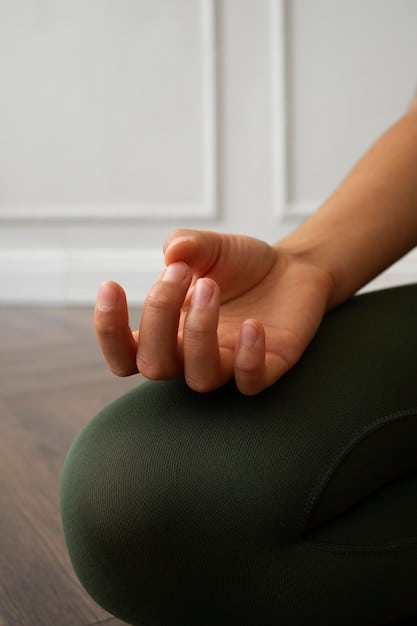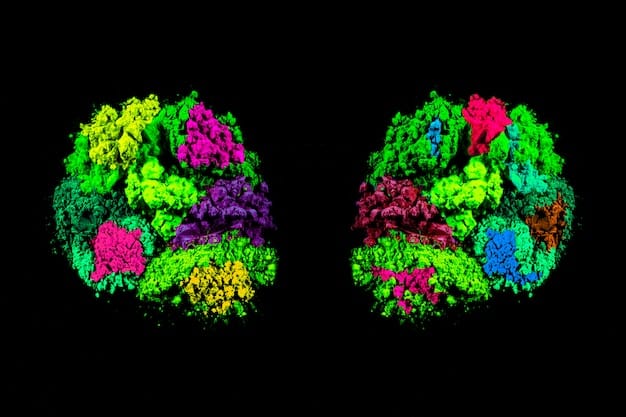Mindfulness Meditation: Reduce Anxiety by 15% in 3 Months

Mindfulness meditation can significantly reduce anxiety levels, with studies suggesting a potential decrease of up to 15% within three months through consistent practice and focused attention to the present moment.
Are you looking for a natural way to ease your anxiety? Discover how mindfulness meditation can reduce anxiety by 15% in 3 months, providing a more peaceful and balanced state of mind.
Understanding Mindfulness Meditation
Mindfulness meditation has emerged as a powerful tool in the realm of mental well-being. It’s not just another trend; it’s a practice rooted in ancient traditions, now supported by modern science. Let’s delve into what mindfulness meditation really is and how it works.
At its core, mindfulness meditation is about training your attention to be present in the moment. It involves observing your thoughts, feelings, and sensations without judgment. This simple act of awareness can have profound effects on your mental and emotional state.

The Essence of Mindfulness
Mindfulness is the psychological process of purposely bringing one’s attention to experiences occurring in the present moment without judgment. It’s about acknowledging and accepting your thoughts and feelings as they arise, without getting carried away by them.
How Meditation Cultivates Mindfulness
Meditation is the practice that helps you cultivate mindfulness. Through regular meditation, you learn to focus your attention, observe your thoughts, and develop a sense of inner calm. This practice can be done in various forms, such as sitting meditation, walking meditation, or even mindful movement.
- Increased Self-Awareness: Mindfulness meditation helps you become more aware of your thoughts, feelings, and physical sensations.
- Reduced Reactivity: By observing your thoughts without judgment, you can reduce your tendency to react impulsively to stressful situations.
- Improved Focus: Regular practice enhances your ability to concentrate and stay focused on the task at hand.
- Emotional Regulation: Mindfulness meditation can help you regulate your emotions and develop a more balanced emotional state.
In essence, mindfulness meditation is a journey of self-discovery and inner peace. By learning to be present in the moment, you can reduce stress, improve your focus, and enhance your overall well-being. This is a foundational element in understanding how it can aid in reducing anxiety.
The Science Behind Anxiety Reduction
Anxiety can feel overwhelming, but understanding the science behind it can empower you to take control of your mental health. Let’s explore the neurological and psychological mechanisms that contribute to anxiety and how mindfulness meditation can counteract these processes.
Anxiety often involves heightened activity in the amygdala, the brain’s emotional center, and decreased activity in the prefrontal cortex, which regulates emotions. This imbalance can lead to increased feelings of fear and worry.
Neurological Basis of Anxiety
Studies have shown that chronic anxiety can lead to structural changes in the brain, affecting the size and function of the amygdala and prefrontal cortex. These changes can further exacerbate anxiety symptoms and make it harder to cope with stress.
Psychological Factors in Anxiety
Psychologically, anxiety is often fueled by negative thought patterns, such as catastrophic thinking and rumination. These thought patterns can create a self-perpetuating cycle of worry and fear.

- Amygdala Regulation: Mindfulness meditation can help regulate the activity of the amygdala, reducing feelings of fear and anxiety.
- Prefrontal Cortex Activation: Regular practice can increase activity in the prefrontal cortex, enhancing emotional regulation and decision-making.
- Thought Pattern Disruption: Mindfulness meditation teaches you to observe your thoughts without judgment, disrupting negative thought patterns and reducing rumination.
- Stress Hormone Reduction: Studies have shown that mindfulness meditation can lower levels of cortisol, the stress hormone, promoting a sense of calm and well-being.
By understanding the science behind anxiety, you can appreciate the potential benefits of mindfulness meditation. It’s not just a feel-good practice; it’s a powerful tool that can help you rewire your brain and take control of your mental health. This foundational understanding is critical for seeing how mindfulness has been tested to statistically reduce anxiety by percentages like 15%.
How Mindfulness Meditation Impacts Anxiety Levels
Mindfulness meditation has been found to impact anxiety levels through several mechanisms. Let’s look into these impacts and how consistent practice can help reduce anxiety symptoms.
Mindfulness meditation encourages a shift in perspective, by observing thoughts and feelings rather than being controlled by them. This detachment reduces the intensity of anxious thoughts and promotes a sense of calm.
Reducing Overthinking
One of the primary ways mindfulness meditation impacts anxiety is by reducing overthinking. By focusing on the present moment, you can quiet the mental chatter and avoid getting caught up in worries about the past or future.
Modulating Emotional Regulation
Mindfulness meditation also helps to modulate emotional regulation. By observing your emotions without judgment, you can develop a greater capacity to handle difficult feelings and reduce your reactivity to stressful situations.
- Present Moment Focus: Mindfulness meditation anchors you in the present moment, reducing worries about future events.
- Non-Judgmental Awareness: Developing an awareness of thoughts and feelings without labeling them as “good” or “bad” can reduce emotional intensity.
- Stress Reduction: Lowering the levels of cortisol helps to improve mood and decrease anxiety.
- Cognitive Flexibility: Enhancing the mind’s ability to shift focus can help break cycles of worry and negative thinking.
Mindfulness meditation serves as a practical method for anxiety reduction. With consistent practice, you can rewire your response to stress and anxiety and improve overall mental well-being.
Practical Steps to Start Mindfulness Meditation
Starting mindfulness meditation might seem daunting, but it can be a simple and accessible practice. Let’s go over practical steps to get started and integrate mindfulness meditation into your daily routine.
Set aside a specific time each day for meditation to create consistency. Start with just 5-10 minutes and gradually increase the duration as you become more comfortable.
Creating a Routine
Choose a quiet and comfortable space where you won’t be disturbed. You can sit on a cushion, chair, or even lie down. Find a position that allows you to relax and maintain awareness.
Various Mindfulness Exercises
There are numerous exercises to focus on when practicing mindfulness. Find what works best for you and begin to build your practice.
- Breath Awareness: Focus on the sensation of your breath as it enters and leaves your body. Notice the rise and fall of your chest or abdomen.
- Body Scan: Bring your attention to different parts of your body, noticing any sensations without judgment. This can help you become more aware of physical tension and discomfort.
- Guided Meditations: Use guided meditation apps or recordings to help you focus and stay on track. These can provide structure and support for your practice.
- Walking Meditation: Pay attention to the sensation of your feet making contact with the ground as you walk. Notice the rhythm of your steps and the movement of your body.
Integrating mindfulness meditation into your daily routine can be simple with the above exercises. Small efforts can lead to significant benefits in managing stress, reducing anxiety, and promoting overall mental well-being.
Tracking Your Progress and Staying Consistent
Tracking your progress is an essential part of any wellness journey, including mindfulness meditation. Let’s explore some ways to track your progress and stay consistent with your practice to achieve the desired results, such as a 15% reduction in anxiety over three months.
Consistency is key in seeing the benefits of mindfulness meditation. Regular practice, even for just a few minutes each day, can lead to significant improvements in your mental and emotional well-being.
Keeping a Meditation Journal
One of the simplest ways to track your progress is by keeping a meditation journal. Write down your experiences after each session, noting any thoughts, feelings, or sensations that arose during your practice.
Utilizing Feedback
Seeking feedback from a professional or sharing experiences with a group is another way to continue consistentcy.
- Mood Tracking: Use a mood tracking app or journal to monitor your anxiety levels and overall mood over time. This can help you identify patterns and see how mindfulness meditation is affecting your mental state.
- Setting Goals: Set realistic goals for your meditation practice, such as meditating for 10 minutes each day or attending a weekly meditation group. Achieving these goals can provide a sense of accomplishment and motivation.
- Finding a Community: Connect with others who are also practicing mindfulness meditation. Sharing your experiences and challenges with others can provide support and encouragement.
- Professional Guidance: Consider working with a mindfulness teacher or therapist for personalized guidance and support. They can help you tailor your practice to your specific needs and goals.
Tracking your progress and staying consistent with your mindfulness meditation practice can lead to meaningful reductions in anxiety. Monitoring your experiences and goals will create feedback and insights. This also helps you maintain the practice as part of your way of life.
Combining Mindfulness with Other Therapies
While mindfulness meditation can be a powerful tool on its own, it can also be combined with other therapies to enhance its benefits. Let’s discover how you can integrate mindfulness with other treatments to create a comprehensive approach to managing anxiety.
Many people find that combining mindfulness meditation with traditional therapies such as cognitive-behavioral therapy (CBT) or medication can provide the best results. It’s important to work with a healthcare professional to determine the right combination for your individual needs.
Integrating CBT into Mindfulness Meditation
Combining cognitive-behavioral therapy with mindfulness meditation focuses on changing any thought patterns and behaviors. This can significantly reduce anxiety levels.
Holistic Medicine
Alternative therapies such as yoga, acupuncture, and herbal remedies play a variety of roles. They can provide support when managing anxiety and enhancing the effects of mindfulness meditation.
- Yoga and Mindfulness: Combining yoga with mindfulness can create a synergistic effect, promoting both physical and mental well-being. Yoga helps to release tension in the body, while mindfulness enhances awareness of your thoughts and feelings.
- Acupuncture and Mindfulness: Acupuncture can help to balance energy flow in the body, reducing stress and anxiety. Combining it with mindfulness meditation can enhance the relaxing and calming effects.
- Herbal Remedies and Mindfulness: Certain herbal remedies, such as chamomile and lavender, have calming properties that can complement mindfulness meditation. However, it’s important to consult with a healthcare professional before using herbal remedies, especially if you are taking medication.
- Lifestyle Changes and Mindfulness: Making positive lifestyle changes, such as getting regular exercise, eating a healthy diet, and getting enough sleep, can also support your mindfulness practice. These changes can help to reduce stress and improve your overall well-being.
Working with mental health professionals not only integrates therapies for a more comprehensive response but ensures any adjustments are met with a personalized and holistic method.
| Key Point | Brief Description |
|---|---|
| 🧘 Focus on Present | Practice focusing on immediate experiences to reduce worries about the future. |
| 🧠 Regulate Emotions | Develop awareness of feelings without judgment to better manage emotional responses. |
| 📈 Track Progress | Monitor your anxiety levels and mood to see how mindfulness meditation impacts you. |
| 🔄 Combine Therapies | Integrate mindfulness with other therapies like CBT for holistic anxiety relief. |
Frequently Asked Questions
▼
Mindfulness meditation is a mental training practice that teaches you to slow down racing thoughts, let go of negativity, and calm both your mind and body. It involves focusing on the present moment and accepting your thoughts and feelings without judgment.
▼
Consistency is more important than duration. Start with 5-10 minutes a day and gradually increase as you become comfortable. Even short, regular sessions can lead to noticeable reductions in anxiety over time.
▼
While mindfulness meditation can significantly reduce anxiety symptoms, it’s not a cure. It’s best seen as a tool to manage anxiety and improve your overall well-being, often used in conjunction with other therapies.
▼
It’s normal for thoughts to arise during meditation. The goal is not to empty your mind, but to observe your thoughts without judgment and gently redirect your attention back to your focus, such as your breath.
▼
Mindfulness meditation is generally safe, but it’s important to approach it with realistic expectations. If you have a history of trauma or severe mental health issues, it’s best to consult with a mental healthcare professional before starting a practice.
Conclusion
Incorporating mindfulness meditation into your daily life can be a transformative step toward reducing anxiety and improving overall mental well-being. By following the steps outlined in this article and tracking your progress, you can potentially achieve a 15% reduction in anxiety within three months, paving the way for a more peaceful and balanced life.





